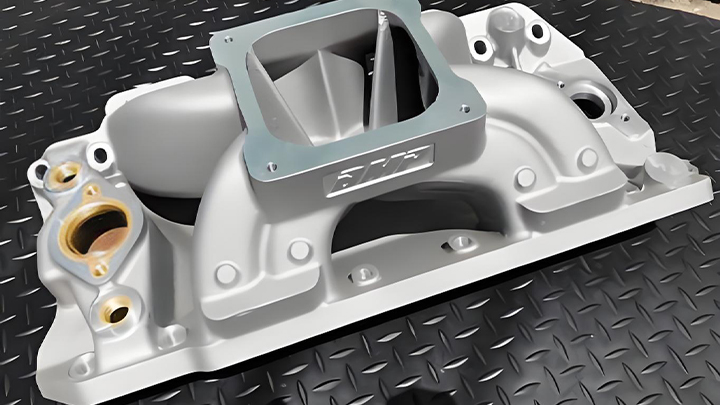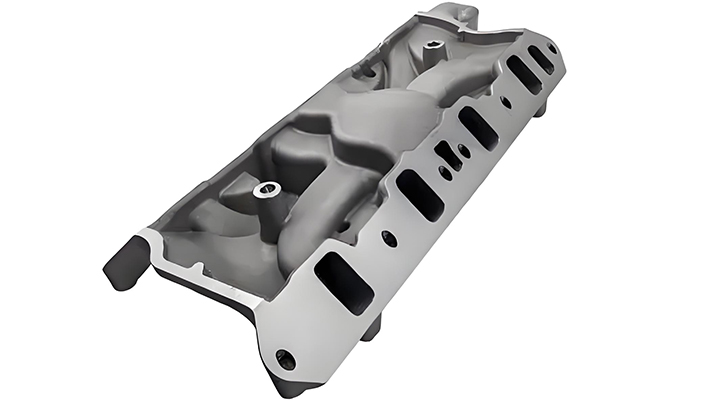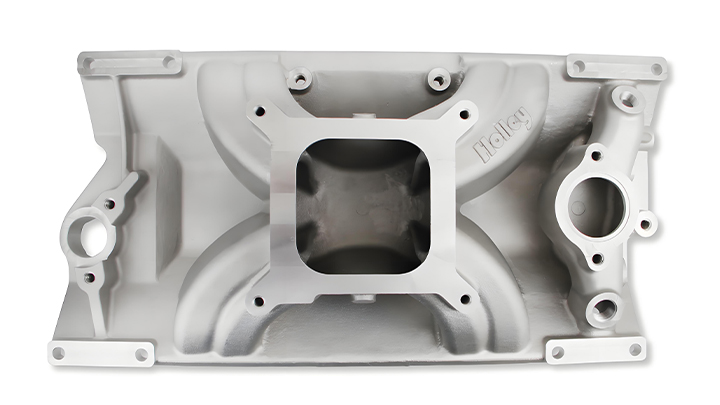The Small Block Chevy (SBC) is a legendary engine that has powered countless vehicles since its introduction in 1955. Over the decades, it has become a favorite among car enthusiasts, racers, and builders for its versatility, reliability, and potential for high performance. One of the most critical components that can significantly enhance the performance of the SBC is the intake manifold. This article delves into the role of the intake manifold in boosting engine power and fuel efficiency, the different types available, and how to choose the right one for your needs.
Understanding the Role of the Intake Manifold
The intake manifold is a crucial component in an internal combustion engine. It is responsible for delivering the air-fuel mixture from the carburetor or throttle body to the engine’s cylinders. The design and efficiency of the intake manifold play a significant role in determining the engine’s performance, affecting factors like horsepower, torque, and fuel efficiency.
For Small Block Chevy engines, the intake manifold is particularly important because it can either limit or enhance the engine’s ability to breathe. A well-designed intake manifold can improve the engine’s volumetric efficiency, allowing it to take in more air and fuel, which leads to better combustion and more power.
Types of Intake Manifolds for Small Block Chevy
There are several types of intake manifolds available for Small Block Chevy engines, each designed to optimize performance in different ways. The main types include:
1. Single-Plane Intake Manifolds
Single-plane intake manifolds are designed for high-performance applications where maximum horsepower is the primary goal. These manifolds feature a large, open plenum that feeds all the engine’s cylinders. The design reduces airflow restrictions, allowing for higher RPMs and more power. However, single-plane manifolds typically sacrifice low-end torque, making them less ideal for street use where drivability is a concern.
Key Benefits:
• High RPM power gains.
• Ideal for racing and high-performance engines.
Considerations:
• Reduced low-end torque.
• Not suitable for daily driving or towing applications.
2. Dual-Plane Intake Manifolds
Dual-plane intake manifolds are designed for a balance of power and drivability. They feature two separate plenums that feed the engine’s cylinders, which helps to improve low-end torque while still providing a reasonable amount of top-end power. Dual-plane manifolds are often the preferred choice for street-driven vehicles or for engines that require a broader power band.
Key Benefits:
• Improved low-end torque.
• Better drivability for street applications.
Considerations:
• May not provide the same high RPM power as single-plane manifolds.
• Ideal for daily driving and moderate performance builds.
3. Tunnel Ram Intake Manifolds
Tunnel ram intake manifolds are designed for maximum airflow and are typically used in drag racing or other high-performance applications. These manifolds have tall, straight runners that allow for a direct path of air into the cylinders. The design is optimized for high RPM performance, making it possible to extract maximum power from a Small Block Chevy engine.
Key Benefits:
• Maximum airflow and horsepower at high RPMs.
• Ideal for drag racing and competition use.
Considerations:
• Not practical for street use due to poor low-end performance.
• Requires modifications to the hood due to the tall design.
How the Intake Manifold Affects Engine Performance
The design of the intake manifold directly impacts the engine’s performance characteristics. Here’s how different aspects of the manifold design can affect the engine:
1. Runner Length and Diameter
The length and diameter of the intake manifold runners can significantly influence engine performance. Longer runners tend to enhance low-end torque, while shorter runners are better for high-RPM power. Similarly, the diameter of the runners affects the airflow; larger diameters allow more air to flow but can reduce air velocity, impacting low-end performance.
2. Plenum Volume
The plenum is the chamber where air gathers before being distributed to the runners. A larger plenum volume can support higher RPMs by providing a greater reserve of air. However, too large a plenum can reduce throttle response and low-end torque, making it less suitable for street applications.
3. Material and Construction
Intake manifolds are typically made from cast aluminum, which offers a good balance of strength, weight, and heat dissipation. However, there are also composite and plastic manifolds that can reduce weight and improve heat resistance. The choice of material can affect both performance and durability, especially in high-performance applications.
Choosing the Right Intake Manifold for Your Small Block Chevy
Selecting the right intake manifold for your Small Block Chevy depends on several factors, including your intended use, engine specifications, and performance goals. Here are some key considerations to keep in mind:
1. Intended Use
If your SBC-powered vehicle is primarily used for street driving, a dual-plane intake manifold is likely the best choice. It provides a good balance of low-end torque and high-RPM power, making it suitable for everyday use. For racing or high-performance builds, a single-plane or tunnel ram manifold may be more appropriate.
2. Engine Specifications
The displacement, camshaft profile, and compression ratio of your engine will influence the type of intake manifold that works best. For example, an engine with a high-lift camshaft and high compression may benefit from a single-plane manifold, while a milder setup might perform better with a dual-plane manifold.
3. Performance Goals
If maximizing horsepower is your primary goal, especially at high RPMs, a single-plane or tunnel ram intake manifold will be the best option. However, if you’re looking for a broader power band that provides good performance across a range of RPMs, a dual-plane manifold is likely the better choice.
Installation Tips and Best Practices
Once you’ve chosen the right intake manifold for your Small Block Chevy, proper installation is crucial to ensure optimal performance. Here are some tips and best practices to follow:
1. Surface Preparation
Before installing the new intake manifold, make sure the mating surfaces on the engine block are clean and free of any debris or old gasket material. This will help ensure a proper seal and prevent any vacuum leaks.
2. Gasket Selection
Choosing the right gasket is essential for a proper seal. Make sure to use a high-quality gasket that matches the intake manifold and cylinder head ports. In some cases, you may need to use a gasket with a thicker or thinner profile to achieve the best seal.
3. Torque Specifications
When bolting down the intake manifold, follow the manufacturer’s recommended torque specifications. Over-tightening can damage the manifold or the cylinder heads, while under-tightening can lead to leaks and poor performance.
4. Check for Vacuum Leaks
After installation, it’s important to check for any vacuum leaks around the intake manifold. A vacuum leak can cause poor engine performance, rough idling, and reduced fuel efficiency. Use a vacuum gauge or smoke test to ensure a proper seal.
Conclusion
The intake manifold is a vital component that can significantly influence the performance of a Small Block Chevy engine. By choosing the right type of intake manifold and ensuring proper installation, you can unlock additional power and improve fuel efficiency, whether you’re building a street machine or a high-performance race car. Whether you opt for a single-plane, dual-plane, or tunnel ram manifold, understanding how each type affects engine performance will help you make an informed decision and get the most out of your SBC.
Investing in a high-quality intake manifold tailored to your engine’s needs is one of the most effective ways to enhance the performance of your Small Block Chevy. With the right setup, you can enjoy increased horsepower, better throttle response, and improved overall drivability.
Post time: Aug-19-2024






